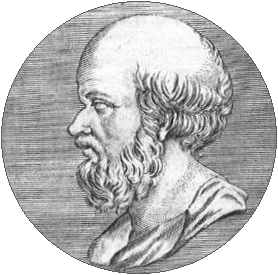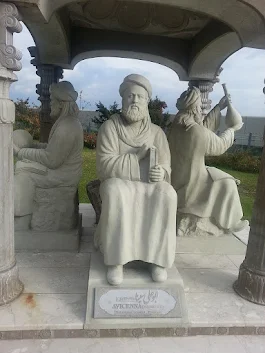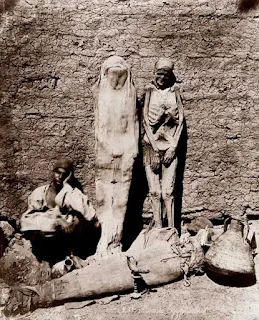Introduction:
The Library of Alexandria stands as one of the most renowned and fascinating cultural and scientific marvels of antiquity. Located in Alexandria, Egypt—Alexander the Great's vision for a cosmopolitan hub—the library symbolized a bold endeavor to collect and preserve all human knowledge. While its legacy is shrouded in mystery and its destruction lamented as a monumental loss, the Library of Alexandria remains a testament to human curiosity, ambition, and intellectual progress.
 |
The Library of Alexandria, 19th-century artistic rendering by German artist O. Von Corven, based partially on the archaeological evidence. ( Public domain ) |
Origins and Foundation:
 |
Forschungen in Ephesos", Vol. III, Vienna 1923, p.128. published by Tomisti ( public domain ) |
The foundation of the Library of Alexandria was intrinsically tied to the ambitions of the Ptolemaic dynasty. After Alexander the Great founded Alexandria in 331 BCE, his successor, Ptolemy I Soter, aimed to transform the city into a center of learning and cultural exchange. Inspired by the library in Athens established under Peisistratos and other Greek and Near Eastern traditions, Ptolemy I sought to create a repository of universal knowledge. His vision was later realized under his son, Ptolemy II Philadelphus, who oversaw the construction of the Mouseion—a larger research institute dedicated to the nine Muses of Greek mythology, of which the library was a central feature.
 |
Ptolemy II Philadelphus Founds the Library of Alexandria Vincenzo Camuccini (Public Domain) |
The Ambitious Scope:
What set the Library of Alexandria apart from its predecessors was its unparalleled ambition to collect every known text in the world. Ptolemaic rulers implemented aggressive and innovative policies to achieve this mission. Royal agents were dispatched across the Mediterranean and beyond, equipped with substantial funds to purchase texts from authors and collectors. Legend holds that all manuscripts aboard ships docking at Alexandria’s harbor were seized, copied by scribes, and returned—sometimes with the originals retained and the copies returned instead. Estimates of the library's collection vary, with scholars suggesting a range from 40,000 to 400,000 scrolls at its zenith.
 |
Plan of Alexandria c 30 BC Otto Puchstein 1890s. ( public domain) |
Knowledge and Innovation:
The Library of Alexandria not only preserved knowledge but actively fostered intellectual inquiry and innovation. Scholars, poets, mathematicians, and scientists from diverse backgrounds were drawn to Alexandria by the generous patronage of the Ptolemaic court. Resident academics were provided with housing, stipends, and access to vast resources. Key figures associated with the library included:
Eratosthenes of Cyrene, who calculated the Earth's circumference with remarkable accuracy.
 |
Etching of an ancient seal identified as Eratosthenes. Philipp Daniel Lippert [de], Dactyliothec, 1767. ( Public domain ) |
Archimedes, whose "Archimedes' screw" revolutionized engineering and agriculture.
 |
Illustration représentant Archimède Dr. Manuel (CC BY-SA) |
Callimachus, who created the Pinakes, an early bibliographic catalog organizing works by subject and author.
 |
Portrait of Callimachus, Wiliam Henry Toms, 1755 ( public domain ) |
Aristarchus of Samos, who proposed a heliocentric model centuries before Copernicus.
 |
Aristarchos of Samos, monument Aristotle University of Thessaloniki/Greece, Dr. Manuel (CC BY-SA) |
Through its lecture halls, gardens, and dining spaces, the Mouseion resembled a modern university campus, facilitating interdisciplinary dialogue. Fields such as astronomy, medicine, mathematics, and philology advanced significantly thanks to this vibrant intellectual environment.
A Symbolic Loss:
Despite its grandeur, the Library of Alexandria became a tragic symbol of the fragility of knowledge. Accounts of its destruction vary widely, with historians attributing its loss to multiple incidents. Some sources claim that Julius Caesar’s siege of Alexandria in 48 BCE resulted in a fire that consumed part of its collection. Others suggest that the library suffered gradual neglect during the decline of the Ptolemaic dynasty and subsequent Roman rule. By the time of Emperor Aurelian’s invasion in the 3rd century CE, the library—or its remaining fragments—was likely destroyed.
Interestingly, the Serapeum, a "daughter library" established near the Serapis temple, continued to house scrolls even after the original library's decline. However, this too was dismantled in 391 CE under the orders of Bishop Theophilus during a Christian crackdown on pagan sites. By this time, the great Library of Alexandria had faded into myth.
 |
Alexandria - View of ruins of the Serapeum from Pompey's Pillar, published by Daniel Mayer, 2008. ( Public domain) |
Surviving Knowledge:
The loss of the Library of Alexandria has often been compared to losing the internet today—a catastrophic disruption to the dissemination of knowledge. Yet not all was lost. Monks, scholars, and scribes painstakingly copied and preserved many texts originally housed in the library. These works continued to influence medieval Europe, the Islamic Golden Age, and the Renaissance. For instance:
Ancient Greek medical texts informed Islamic scholars like Avicenna.
 |
Persian Scholar Pavilion in Vienna International Centre donated by Iran. Jun 2009, published by Yamaha5 in wiki Commons ( public domain ) |
Astronomical and mathematical advancements influenced later European developments, including the work of Copernicus and Galileo.
 |
Galileo Demonstrating His Telescope,Henry-Julien Detouche (Public Domain) |
 |
Cropped image of page 9 verso of the autograph manuscript of Nicolaus Copernicus: De Revolutionibus Orbium Coelestium (1520-1541) Published in Wikimedia Commons ( public domain ) |
The organization and cataloging techniques of the Pinakes served as a precursor to modern libraries.
 |
| British Museum Reading Room Panorama. ( Public domain) |
Legacy in Modern Times:
The Library of Alexandria serves as an enduring metaphor for the pursuit of knowledge and the necessity of its preservation. Recognizing this legacy, the Bibliotheca Alexandrina was inaugurated in 2002 near the site of the ancient library. Designed to embody the spirit of its predecessor, this contemporary library houses millions of books, research facilities, and state-of-the-art digital archives. While it may never replicate the grandeur of the original, the Bibliotheca Alexandrina symbolizes a renewed commitment to learning and global collaboration.
 |
The Bibliotheca Alexandrina's interior, from near the top, published by Carsten w ( public domain) |
Conclusion:
The Library of Alexandria remains a poignant reminder of human ambition and vulnerability. Its founders' vision to centralize all knowledge of the ancient world reflects a boundless curiosity that transcends cultures and eras. Simultaneously, its loss underscores the impermanence of even the greatest achievements without the diligence to preserve them. The story of the library is not just a narrative about books but a testament to the universal and timeless value of knowledge in shaping civilizations. Through continued efforts to study, document, and disseminate wisdom, we honor the legacy of this ancient treasure that forever changed the intellectual history of humanity.
Bibliography :
Books:
1. Canfora, L. (1990). The Vanished Library: A Wonder of the Ancient World. University of California Press.
2. El-Abbadi, M. (1992). The Life and Fate of the Ancient Library of Alexandria. UNESCO Publishing.
3. Kassab, G. (1998). Alexandria, a City of Knowledge. Dar al-Maarif.
4. Fraser, P. M. (2001). Ptolemaic Alexandria. Oxford University Press.
5. Hardy, G. H. (1971). Libraries of Ancient Alexandria and Rome. Greenwood Press.
Journal Articles:
6. MacLeod, R. (2000). “The Library of Alexandria: Centre of Learning in the Ancient World.” History Today, 50(7), 16–23.
7. Canfora, L. (1990). “Destruction of the Alexandrian Library: Examining the Evidence.” The Classical Quarterly, 38(2), 555–567.
8. Kassab, G. (1987). "Science, Knowledge, and Alexandria." Journal of Ancient History, 21(4), 422–439.
9. Thompson, D. J. (2003). “Philology at the Library of Alexandria.” Journal of Hellenic Studies, 123, 85–98.
10. Grafton, A. (2008). "Lost Libraries of Alexandria: A History." American Historical Review, 113(5), 1391–1412.
Online Resources and Databases:
11. UNESCO. (2002). The Alexandria Library Revival Project.
12. Bagnall, R. (2008). “Papyrology and the Lost Texts of Alexandria.” Open Access Journal of Papyrology. Read Online
13. Library of Congress. (n.d.). "Legacy of the Alexandria Library." Digital Collection
Dissertations and Theses:
14. Alkins, J. R. (1989). Knowledge and Power: The Alexandrian Library under Ptolemaic Rule. (Doctoral dissertation). University of Michigan.
15. Thompson, G. B. (2012). The Role of the Museum and Library in Ancient Alexandria. (Master's thesis). University of Oxford.
Conference Proceedings:
18. Hussain, M., & Robinson, J. (Eds.). (2010). Alexandria Revisited: Papers from the International Conference on Knowledge in Antiquity. Institute of Hellenic Studies, Athens.






._Wellcome_V0004455.jpg)









.jpg)






